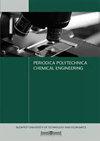微生物聚酯制备孔径可控的高孔支架
IF 1.8
4区 工程技术
Q3 ENGINEERING, CHEMICAL
引用次数: 0
摘要
微生物聚酯在组织工程领域的应用有限,尽管这些聚合物的生物相容性使它们成为这一角色的理想候选者。阻碍微生物聚酯在这个市场上扩散的主要因素是,用静电纺丝或3D打印等传统技术加工它们是具有挑战性的。然而,这些生物聚合物的全部潜力仍然可以通过应用非常规的制造方法来利用,例如基于盐浸概念的方法。这一概念的实施促进了支架的生产,同时具有高孔隙率和优异的渗透性。此外,平均孔径也可以在50到400µm范围内变化,据报道,这是培养真核细胞培养的最佳孔径。通过调整孔隙大小,支架可以根据组织组成的真核细胞进行调整。此外,我们还开发了一种全新的计算方法来近似支架的孔径分布。该方法依赖于数字光学显微镜软件重建的三维数据,也便于支架平均孔径的建模。因此,我们的方法除了可以控制孔隙大小外,还可以对其进行预测。本文章由计算机程序翻译,如有差异,请以英文原文为准。
Preparation of Highly Porous Scaffolds with Controllable Pore Size from Microbial Polyesters
Microbial polyesters saw limited use in the field of tissue engineering, even though the biocompatibility of these polymers makes them ideal candidates for this role. The primary factor that hinders the proliferation of microbial polyesters in this market is that their processing with conventional techniques, such as electrospinning or 3D printing, is challenging. However, the full potential of these biopolymers could still be utilized by applying unconventional manufacturing methods, such as those based on the concept of salt leaching. An implementation of this concept facilitates the production of scaffolds that simultaneously have high porosity and excellent permeability. Moreover, the average pore size can also be varied in the range from 50 to 400 µm, which was reported to be optimal for the cultivation of eucaryotic cell cultures. By adjusting the pore size, the scaffold can be tailored to the eucaryotic cells the tissue consists of. Furthermore, we have developed an entirely new computational method for the approximation of the pore size distribution of the scaffolds. The method relies on 3D data reconstructed by the software of a digital optical microscope and also facilitates the modeling of the average pore size of scaffolds. Thus, besides the control of the pore size, our method enables its prediction as well.
求助全文
通过发布文献求助,成功后即可免费获取论文全文。
去求助
来源期刊

Periodica Polytechnica Chemical Engineering
ENGINEERING, CHEMICAL-
CiteScore
3.10
自引率
7.70%
发文量
44
审稿时长
>12 weeks
期刊介绍:
The main scope of the journal is to publish original research articles in the wide field of chemical engineering including environmental and bioengineering.
 求助内容:
求助内容: 应助结果提醒方式:
应助结果提醒方式:


